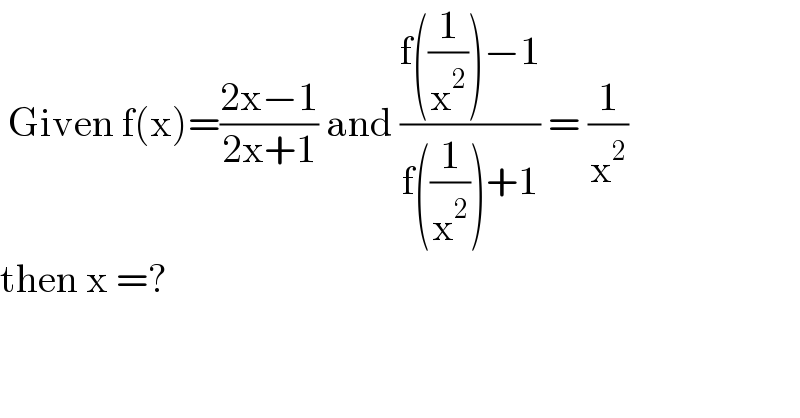
Previous in Relation and Functions Next in Relation and Functions
Question Number 129213 by bramlexs22 last updated on 13/Jan/21

$$\:\mathrm{Given}\:\mathrm{f}\left(\mathrm{x}\right)=\frac{\mathrm{2x}−\mathrm{1}}{\mathrm{2x}+\mathrm{1}}\:\mathrm{and}\:\frac{\mathrm{f}\left(\frac{\mathrm{1}}{\mathrm{x}^{\mathrm{2}} }\right)−\mathrm{1}}{\mathrm{f}\left(\frac{\mathrm{1}}{\mathrm{x}^{\mathrm{2}} }\right)+\mathrm{1}}\:=\:\frac{\mathrm{1}}{\mathrm{x}^{\mathrm{2}} } \\ $$$$\mathrm{then}\:\mathrm{x}\:=? \\ $$
Answered by liberty last updated on 13/Jan/21

$$\:\mathrm{f}\left(\frac{\mathrm{1}}{\mathrm{x}^{\mathrm{2}} }\right)−\mathrm{1}=\frac{\frac{\mathrm{2}}{\mathrm{x}^{\mathrm{2}} }−\mathrm{1}}{\frac{\mathrm{2}}{\mathrm{x}^{\mathrm{2}} }+\mathrm{1}}−\mathrm{1}=\frac{\mathrm{2}−\mathrm{x}^{\mathrm{2}} }{\mathrm{2}+\mathrm{x}^{\mathrm{2}} }−\mathrm{1}=\frac{−\mathrm{2x}^{\mathrm{2}} }{\mathrm{2}+\mathrm{x}^{\mathrm{2}} } \\ $$$$\:\mathrm{f}\left(\frac{\mathrm{1}}{\mathrm{x}^{\mathrm{2}} }\right)+\mathrm{1}=\frac{\frac{\mathrm{2}}{\mathrm{x}^{\mathrm{2}} }−\mathrm{1}}{\frac{\mathrm{2}}{\mathrm{x}^{\mathrm{2}} }+\mathrm{1}}+\mathrm{1}=\frac{\mathrm{2}−\mathrm{x}^{\mathrm{2}} }{\mathrm{2}+\mathrm{x}^{\mathrm{2}} }+\mathrm{1}=\frac{\mathrm{4}}{\mathrm{2}+\mathrm{x}^{\mathrm{2}} } \\ $$$$\left(\because\right)\left(\therefore\right)\Rightarrow\:\frac{\mathrm{f}\left(\frac{\mathrm{1}}{\mathrm{x}^{\mathrm{2}} }\right)−\mathrm{1}}{\mathrm{f}\left(\frac{\mathrm{1}}{\mathrm{x}^{\mathrm{2}} }\right)+\mathrm{1}}\:=\:−\frac{\mathrm{1}}{\mathrm{2}}\mathrm{x}^{\mathrm{2}} =\frac{\mathrm{1}}{\mathrm{x}^{\mathrm{2}} }\: \\ $$$$\:\mathrm{x}^{\mathrm{4}} +\mathrm{2}=\mathrm{0}\:\Rightarrow\left(\mathrm{x}^{\mathrm{2}} −{i}\sqrt{\mathrm{2}}\right)\left(\mathrm{x}^{\mathrm{2}} +{i}\sqrt{\mathrm{2}}\right)=\mathrm{0} \\ $$$$\:\mathrm{x}=\pm\sqrt{{i}\sqrt{\mathrm{2}}}\:;\:\mathrm{x}=\pm\sqrt{−{i}\sqrt{\mathrm{2}}}\: \\ $$
Answered by mr W last updated on 14/Jan/21

$${f}\left({x}\right)=\mathrm{1}−\frac{\mathrm{2}}{\mathrm{2}{x}+\mathrm{1}} \\ $$$${let}\:{t}=\frac{\mathrm{1}}{{x}^{\mathrm{2}} } \\ $$$$\frac{{f}\left({t}\right)−\mathrm{1}}{{f}\left({t}\right)+\mathrm{1}}=\frac{\mathrm{1}−\frac{\mathrm{2}}{\mathrm{2}{t}+\mathrm{1}}−\mathrm{1}}{\mathrm{1}−\frac{\mathrm{2}}{\mathrm{2}{t}+\mathrm{1}}+\mathrm{1}}=\frac{−\mathrm{1}}{\mathrm{2}{t}}={t} \\ $$$$\Rightarrow{t}^{\mathrm{2}} =−\frac{\mathrm{1}}{\mathrm{2}} \\ $$$$\Rightarrow\frac{\mathrm{1}}{{x}^{\mathrm{4}} }=−\frac{\mathrm{1}}{\mathrm{2}} \\ $$$$\Rightarrow{x}^{\mathrm{4}} =−\mathrm{2}=\mathrm{2}{e}^{\pi{i}} \\ $$$$\Rightarrow{x}=\sqrt[{\mathrm{4}}]{\mathrm{2}}{e}^{\left(\frac{{k}\pi}{\mathrm{2}}+\frac{\pi}{\mathrm{4}}\right){i}} \:\:\:\:\left({k}=\mathrm{0},\mathrm{1},\mathrm{2},\mathrm{3}\right) \\ $$$$\:\:\:\:\:\:\:\:=\frac{\mathrm{1}}{\:\sqrt[{\mathrm{4}}]{\mathrm{2}}}\left(\mathrm{1}+{i}\right),\:\frac{\mathrm{1}}{\:\sqrt[{\mathrm{4}}]{\mathrm{2}}}\left(−\mathrm{1}+{i}\right),\:\frac{\mathrm{1}}{\:\sqrt[{\mathrm{4}}]{\mathrm{2}}}\left(−\mathrm{1}−{i}\right),\:\frac{\mathrm{1}}{\:\sqrt[{\mathrm{4}}]{\mathrm{2}}}\left(\mathrm{1}−{i}\right) \\ $$
